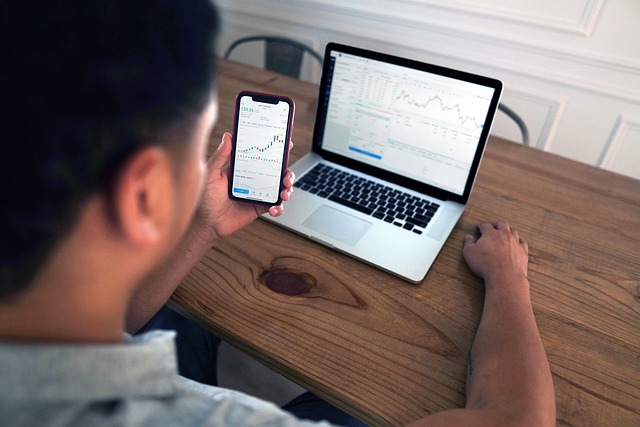Can You Make Money With Trading Bots in 2025?
Author: Jameson Richman Expert
Published On: 2025-11-01
Prepared by Jameson Richman and our team of experts with over a decade of experience in cryptocurrency and digital asset analysis. Learn more about us.
Can you make money with trading bots is one of the most-asked questions among traders and crypto investors in 2025. This article provides a comprehensive, practical guide that explains how trading bots work, realistic profit expectations, the strategies that tend to succeed, platform and exchange choices, risk controls, legal and tax considerations, and step-by-step instructions to set up and test a bot. You’ll get actionable examples, ROI calculations, and links to reputable sources and platforms so you can decide whether automated trading fits your goals.

What are trading bots and how do they work?
Trading bots are software programs that execute buy and sell orders automatically based on predefined rules. They interact with exchange APIs to monitor markets, place orders, and manage positions 24/7. Bots can be simple (rule-based) or complex (machine-learning / AI-driven). The underlying principle is algorithmic trading—removing human emotion and executing strategies at scale and speed.
For a concise technical overview, see the Wikipedia page on algorithmic trading, and Investopedia’s explainer on algorithmic trading basics.
Types of trading bots
- Trend-following bots — buy when price exceeds moving averages, sell when trends reverse.
- Mean-reversion bots — assume price will return to a mean after deviations.
- Market-making bots — post both buy and sell limit orders to capture spreads.
- Arbitrage bots — exploit price differences across exchanges or products.
- AI / ML-driven bots — use pattern recognition, reinforcement learning, or ensemble models.
If you’d like a deep dive into AI-driven crypto bots and real-world discussion, read this Reddit-centered analysis of Binance’s AI trading bot: Binance AI trading bot — a deep dive.
Can you make money with trading bots? (Realistic expectations)
Short answer: yes, but not guaranteed and not without skills and risk management. Trading bots can generate profits, but outcomes depend on many variables: the strategy's edge, market conditions, fees, slippage, latency, capital size, and your discipline in testing and monitoring.
Expectations by experience level:
- Beginner: May break even or lose during initial months. Learning curve on backtesting and parameter tuning is steep.
- Intermediate: After robust testing and risk rules, possible low-to-moderate returns (e.g., 10–50% annual in some crypto strategies), but with drawdowns.
- Advanced: Quant funds and professional teams can achieve higher, more consistent returns via sophisticated models, high capital, and infrastructure.
Examples of outcomes:
- A simple trend-following bot operating BTC/USDT with conservative risk control might return 20–40% in a trending bull year but will underperform during choppy sideways markets.
- An arbitrage bot that captures tiny price differences across exchanges can make consistent small returns, but profits scale with capital and speed; fees and transfer times can erode edges.
Key point: profitability is strategy- and environment-dependent. A bot can be profitable in some regimes and lose money in others.
Key factors that determine profitability
- Strategy edge: Does the strategy have statistical advantage (positive expectancy) after fees and slippage?
- Market regime: Trending vs. mean-reverting markets favor different bots.
- Execution quality: Latency, order types, and exchange liquidity matter.
- Fees and funding costs: Maker/taker fees, funding rates in perpetual futures, and withdrawal fees.
- Capital allocation: Diversification, position sizing, and maximum drawdown constraints.
- Backtesting validity: Out-of-sample testing, walk-forward, and avoiding overfitting.
- Risk management: Stop-losses, dynamic sizing, and circuit breakers.
- Security: Protect API keys and use exchange security features.

Popular bot strategies explained (with examples)
Trend-following
Mechanics: Enter trades in the direction of persistent price movement (e.g., crossover of 50-day and 200-day moving averages). Example: buy when 20EMA crosses above 50EMA; exit on cross back or trailing stop.
Pros: Works well in sustained bull or bear markets. Scales with momentum.
Cons: Poor during sideways markets with false breakouts; requires larger stops which increase drawdowns.
Mean reversion
Mechanics: Identify overbought/oversold conditions (Bollinger Bands, RSI) and take countertrend positions expecting reversion to mean.
Pros: Can produce many small wins in range-bound markets.
Cons: Vulnerable to trend breakouts; needs strict risk controls.
Market making
Mechanics: Place limit buy and sell orders around the mid-price to capture spread when market trades through both sides.
Pros: Potentially steady income, especially with rebates for maker orders.
Cons: Inventory risk, adverse selection during volatile moves; requires deep liquidity and fast execution.
Arbitrage
Mechanics: Simultaneously buy an asset on one exchange and sell on another when price difference exceeds costs.
Pros: Lower directional market risk if executed cleanly.
Cons: Capital-intensive, requires fast execution and often cross-exchange transfer delays; fees and withdrawal restrictions matter.
AI / ML-driven strategies
Mechanics: Use models to predict short-term price moves, regime shifts, or optimal execution. Models can include neural networks, reinforcement learning, or ensembles.
Pros: Can find nonlinear patterns human rules miss.
Cons: Risk of overfitting; requires high-quality features, large datasets, and continuous retraining. For an in-depth industry view and community reactions to AI trading tools, check this analysis: Binance AI Trading Bot — Reddit Deep Dive.
Backtesting and forward testing — do it the right way
Backtesting is essential but often misleading if done incorrectly. Follow these best practices:
- Use high-quality historical data: include tick or 1-minute candles with realistic spreads.
- Account for all costs: maker/taker fees, slippage assumptions, exchange withdrawal fees, funding rates.
- Out-of-sample testing: Reserve at least 20–30% of data for validation.
- Walk-forward analysis: Retrain parameters periodically and test on unseen windows.
- Monte Carlo simulations: Randomize trade order/time to estimate distribution of returns.
- Paper trading/forward testing: Test in live, non-funded or minimal-risk conditions before full deployment.
Remember: past performance is not a guarantee of future returns. Market microstructure changes, new participants, or exchange policy changes can eliminate a previously profitable edge.
Choosing exchanges and platforms
Your choice of exchange affects execution speed, fees, liquidity, and reliability. For crypto trading bots, major exchanges include Binance, Bybit, Bitget, MEXC, and Kraken (for margin info, see their margin trading pages). Here are quick notes and sign-up links to get started:
- Binance — deep liquidity and many products. Sign up: Register with Binance.
- MEXC — growing liquidity and competitive fees. Sign up: Register with MEXC.
- Bitget — strong derivatives offering and copy-trading features. Sign up: Register with Bitget.
- Bybit — fast matching engine and derivatives. Sign up: Register with Bybit. If you’re in Canada and wondering exchange availability, read this guide: Is Bybit available in Canada (2025)?
When choosing, consider:
- API stability and rate limits
- Order types (IOC, post-only, stop-limit, iceberg)
- Liquidity for your target pairs
- Security reputation and insurance funds
- Regulatory compliance in your jurisdiction

Using leverage and margin safely
Leverage magnifies both gains and losses. If your bot uses futures or margin, read and understand margin rules, maintenance margin, and funding rates. For an in-depth look at margin trading and associated risks, review this resource explaining Kraken’s leverage and risk management: Can you trade with leverage on Kraken — guide.
Best practices with leverage:
- Use low leverage (<= 3x) for algorithmic strategies unless you have strict volatility controls.
- Set dynamic position sizing based on recent volatility (e.g., ATR-based sizing).
- Monitor funding rates and rebalance if they become a persistent cost.
- Ensure bots can close positions quickly in emergency market moves.
Security and operational considerations
Security is non-negotiable. Follow these steps:
- Use exchange API keys with least-privilege: enable trading but disable withdrawals for bots.
- Store keys in secure vaults or environment variables; rotate periodically.
- Use two-factor authentication (2FA) for exchange accounts.
- Limit IP access for API keys where possible.
- Test on small capital or paper-trade before scaling up.
Operational reliability:
- Host bots on reliable cloud instances with monitoring and auto-restart.
- Implement logging, alerting (slippage, order rejections, large drawdowns).
- Keep fallback logic: if exchange API fails, pause trading or switch to backup exchange.
Tax and legal considerations
Trading profits are taxable in most jurisdictions. Keep precise records of trades, P&L, fees, and transfers. For U.S. taxpayers, the IRS provides guidance on virtual currencies: IRS virtual currency guidance. For regulatory compliance, consult your local tax authority or a qualified accountant.

How to set up a trading bot — step-by-step (example)
Below is a compact, practical roadmap to go from idea to live deployment.
- Define the strategy — choose indicators, entry/exit rules, position sizing, and risk limits. Example: mean-reversion on ETH/USDT using RSI(14) < 30 to buy and > 70 to sell, with 1% fixed stop-loss and 2% take-profit.
- Collect historical data — download minute or tick data for target pairs (1–3 years where possible).
- Backtest — include fees, slippage, and realistic order fills. Save results and metrics (Sharpe, win rate, max drawdown).
- Validate — out-of-sample and walk-forward testing to avoid overfitting.
- Paper trade — run the bot on live market data without real funds or with small capital for 4–12 weeks.
- Set up infrastructure — cloud hosting, monitoring, log rotation, and alerts.
- Deploy with scale rules — start small (1–5% of target capital), review performance weekly, and ramp gradually.
- Ongoing maintenance — retrain parameters as needed, patch software, and review exchange policy changes.
Costs to expect and ROI examples
Common costs:
- Exchange trading fees (maker/taker)
- Funding rates for perpetuals
- Withdrawal fees and deposit delays
- Infrastructure costs (cloud VM, storage)
- Bot platform / subscription fees (some SaaS solutions)
ROI example — market-making (simplified):
Assume:
- Average spread captured per round-trip: 0.05%
- Trades per day: 200
- Effective capital deployed: $50,000
- Fees and slippage reduce edge by 40%
Gross daily return = 200 * 0.0005 * $50,000 = $5,000 (this number demonstrates scale; in reality spreads are smaller). Adjusting for 40% cost reduction -> net daily $3,000, annualized unrealistic if sustained. This demonstrates why scale and realistic spread/fee assumptions matter. Always run conservative scenarios.
ROI example — trend-following (simplified):
- Capital: $10,000
- Average annual return: 25% (example in favorable regime)
- Annual profit: $2,500
- Max drawdown: 20% -> downside protection and stop-lossing are essential
Bottom line: small edge compounded can outperform frequent small wins, but drawdowns and behavioral discipline determine long-term success.
Common mistakes traders make with bots
- Overfitting — optimizing parameters to historical noise.
- Ignoring fees and slippage — unrealistic backtest assumptions.
- Lack of monitoring — leaving bots unattended through exchange outages or rogue trades.
- Using high leverage without contingency plans.
- Underestimating infrastructure risk like API rate limits or DDOS attacks.
- Poor risk management — no stop losses or position limits.

Advanced topics: market making, arbitrage, AI-driven bots
Market making and arbitrage require institutional-level attention: colocated servers, multi-exchange connectivity, and significant capital to cover inventory risk and withdrawals. If interested in AI-driven systems, research and simulate with out-of-sample data. For market insights and strategic frameworks, consult resources like this strategic blueprint on dominating competition in dynamic environments: Strategic blueprint for dominating market competition.
What to trade with your bot — asset selection
Asset choice impacts volatility, liquidity, and fees. Blue-chip crypto pairs (BTC, ETH) generally have deep liquidity and tighter spreads. Lower-cap altcoins may present larger price swings and less liquidity, increasing slippage and risk. For analysis on which cryptocurrencies may be appropriate to trade in specific market environments, see this guide: Which crypto to buy today — strategic guide.
Combining bots and manual trading
Many successful traders use hybrid approaches: let bots manage standard rule-based tasks (scalping, market-making), while human oversight handles macro decisions, news events, and portfolio rebalancing. Bots are best for repetitive tasks; humans add context and judgement.

Where to learn more and community resources
- Developer docs of exchanges (Binance API, Bybit API, Bitget API, MEXC API)
- Algorithmic trading books and university lectures (look for quant finance lecture notes at major universities)
- Forums, GitHub repositories, and research communities
- Industry analyses and case studies — e.g., AI trading bot reviews: Binance AI deep dive.
Checklist before you deploy a trading bot
- Backtested with realistic costs and out-of-sample validation
- Paper-traded successfully for a minimum period (4–12 weeks)
- Robust risk management rules (max drawdown, position limits)
- Secure API keys and no withdrawal permissions
- Monitoring and alerting in place
- Tax and regulatory understanding for your jurisdiction
- Plan for worst-case scenarios (exchange outages, cascading liquidations)
Getting started — recommended exchanges and signup
If you’re ready to test bots on live exchanges, these platforms are popular with bot developers. Sign-up links (affiliate/referral):
- Binance — Register Binance
- MEXC — Register MEXC
- Bitget — Register Bitget
- Bybit — Register Bybit
Before signing up, verify compliance with local regulations and whether the exchange supports the features and API rate limits your bot needs. If you need details about Bybit availability in Canada, see this guide: Bybit in Canada (2025) guide.

Final thoughts — is automated trading right for you?
To answer can you make money with trading bots decisively: it’s possible, but success requires more than turning on software. You need a repeatable edge, proper testing, robust risk controls, secure operations, and realistic expectations. Many retail traders underestimate the ongoing work—data maintenance, monitoring, and adapting strategies as markets change.
If you’re systematic, disciplined, and committed to continuous improvement, trading bots can be a powerful tool in your trading toolkit. Start small, test thoroughly, and treat bots as a constantly evolving system rather than a “set it and forget it” shortcut.
Further reading and recommended resources
- Algorithmic trading basics — Wikipedia: Algorithmic trading
- Algorithmic trading fundamentals — Investopedia: Algorithmic trading
- Deep dive on AI trading bots and community perspectives — Binance AI deep dive
- Strategic frameworks for competition and innovation — Strategic blueprint
- Crypto selection guides — Which crypto to buy today
- Margin and leverage considerations — Kraken margin trading guide
If you want, I can help you design a starter strategy, provide a backtesting checklist, or recommend bot platforms and code templates tailored to your experience and capital. Which would you prefer next?